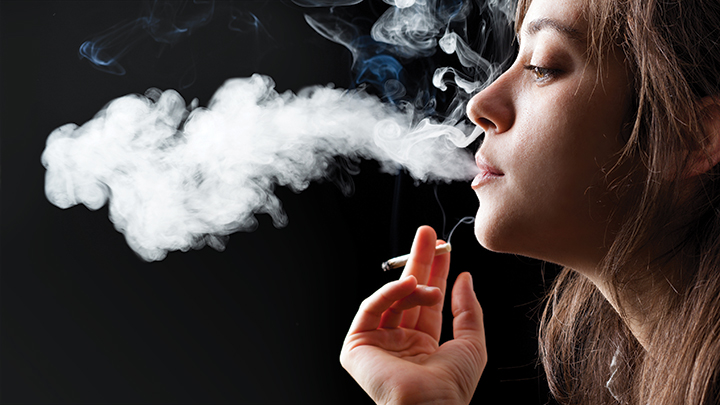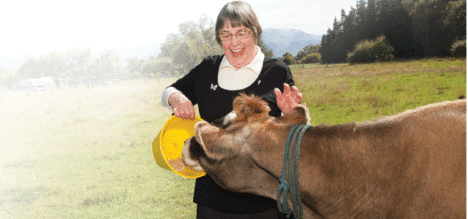
My nose curled at the acrid smell of tobacco. Mixed with the fumes from the passing traffic on the Gold Coast Highway it made me want to cough.
I turned, with my phone held to my ear, and saw a young woman, who was maybe 20, standing at the kerb of the crossing next to me. Between her lips she nursed a cigarette, tendrils of smoke floating in my direction.
“When I see a breast cancer patient, her partner is supportive, her kids are supportive, her workplace is supportive,” said radiation oncologist Dr Bronwyn King, who I was on the phone to at the time—she was driving home, I was on my late afternoon walk. “Everybody is happy to wear a pink ribbon, raise money and bend over backwards to be supportive for this woman.”
The little green man flickered into view and I quickly stepped onto the road, grateful to leave the young woman and her cigarette behind.
“On the other hand, when we see patients diagnosed with lung cancer, often family members are angry at them,” King, who works at the Peter MacCallum Cancer Centre and Epworth Hospital in Melbourne, continued. “At the same time that patient is facing a very serious diagnosis with often a much poorer outcome, and there is often very little sympathy from the general community. Where are the fundraisers for sufferers of lung cancer? Where are the marches? It’s treated as an invisible disease and yet the numbers it kills are staggering.”
King was right. The numbers are profound. According to the World Health Organisation, more than seven million people worldwide die from using tobacco each year. And in Australia, lung cancer cuts short the lives of more than 160 people every week.
“The tobacco industry talks about ‘replacement customers’ because so many of their existing customers die,” King, who is 43, went on. “The problem with cigarettes is that they’ve been deliberately designed to be incredibly addictive, so you don’t have to be exposed to many before your body craves the product.”
I glanced back at the young woman and saw the glowing tip swinging in her fingers as she walked. So casual. So oblivious. And I had a sudden image of my four-year-old daughter switching places in 16 years, and I felt a pang of guilt for being so judgemental.
Incredibly addictive
The most addictive element of tobacco: nicotine—which, according to The American Heart Association, is at least as hard to quit as heroin—stimulates our brain’s reward system. It takes less than 20 seconds after inhaling tobacco for nicotine to enter the bloodstream and cross the blood-brain barrier, delivering an almost instant hit.
But cigarettes don’t just contain nicotine. They also contain over 4000 other chemicals, more than 60 of which have been identified as carcinogens. The big four diseases that smoking causes are lung cancer, emphysema, heart disease and stroke. But it is also known to cause 18 other cancers, including head and neck and bladder cancer.
“Imagine if this was Ebola,” King said. “Look at the global efforts to contain it whenever there’s an outbreak. And yet the Ebola virus has killed less than 12,000 people. You can’t even compare that number to how many people tobacco kills. More people than that die from tobacco every day.”
Thankfully—due in part to anti-smoking campaigns, plain packaging laws and tax increases—smoking rates in Australia, as well as other developed countries, have been steadily falling over the past two decades. Figures from the Australian Bureau of Statistics show that one in seven Australian adults were smokers in 2015, compared with one in four 20 years ago; however, this downward trend may be plateauing.
“There has been no significant drop in the smoking rate from 2013 to 2016,” Associate Professor Colin Mendelsohn, of the University of New South Wales School of Public Health and Community Medicine, said when I spoke to him. “This is the first time there has not been a decline in smoking rates for decades.”
In China, which boasts the highest number of smokers in the world, smoking rates are not declining, and in many developing countries, particularly in parts of Africa where tobacco companies are taking advantage of lax tobacco-related laws to break into new markets, the smoking rates are actually rising.
Time to quit?
Gold Coast-based general practitioner Mark Jeffery says a lot of people struggle to give up. “Some people enjoy smoking as a pleasurable thing,” he told me when I visited his practice. “All we can do as doctors is try and encourage them to quit. The problem is, with some smokers, they start to switch off when you keep telling them not to smoke.
“The most influential time at which to raise the subject of quitting is when people have a critical event—that is, when they are diagnosed with a chronic health condition,” he continued. “It’s at that point that patients have to make a lifestyle change, and they are more open to quitting because they have evidence of the harm smoking is doing to them.”
King is all too familiar with the human cost of tobacco. As a clinician, she has stood at the bedside witnessing the pain of teenage children saying goodbye to their 43-year-old mother who was dying of lung cancer.
King has two small boys herself, and finds her biggest motivation to create change comes from the realisation that we are leaving behind a health crisis for our youngest generation. “When I think about the long term, tobacco is set to be a catastrophic burden, both economically and socially,” she told me. “The annual number of tobacco-related deaths has not yet peaked so we still have a very long way to go.”
The activist doctor
King has been lobbying hard to hit tobacco companies where it hurts most: the profit margin. It all began in 2010 when she discovered that her superannuation fund, Health Super, was—despite its name—investing money in big tobacco companies such as Phillip Morris and British American Tobacco.
King went into immediate action. Together with Peter MacCallum’s CEO Craig Bennett, she requested a meeting with Health Super, calling on the executives and investment team to renounce tobacco.
The best time to raise the subject of quitting is when people experience a critical event.
It was the start of a two-year process involving multiple meetings and discussions that culminated in the first of many victories for King. The fund, which was acquired by First State Super during the negotiations, became the first superannuation provider in Australia to divest its $200 million worth of shares in tobacco.
King’s elation, however, was tempered with the realisation that the victory came with a deeper sense of responsibility. If she was able to influence one superannuation fund, why not other financial institutions?
King founded the not-for-profit organisation Tobacco Free Portfolios and spent what little free time she had on her phone and on her laptop, spreading her message. Meetings with finance directors or investment managers often had a snowball effect. Convincing board members one at a time, she would not give up until the welcome email from a CEO had come through, announcing that their portfolio was now tobacco free.
“At first it was really just about me and my own superannuation fund, but now it’s become about disentangling the global finance sector from the tobacco industry,” King said.
At last count, her organisation has convinced 41 out of the 344 non-self-managed super funds in Australia to divest from tobacco. In 2016, the world’s third largest insurer, France’s AXA Group, announced it would relinquish its €1.8 billion worth of tobacco stock following six years of campaigning by King. In December 2017, The BT Financial group went tobacco free. Australian Super, Telstra Super and OP Trust, a large Canadian pension fund, have all dropped tobacco. And at the United Nations Office at Geneva, King and her team were on site to witness the CEO of BNP Paribas—the world’s seventh largest bank—announce that his organisation was now tobacco free.
Next steps
On a global level, King says the most important thing countries should do is to implement the provisions of the UN Tobacco Treaty, which aims to limit tobacco use by encouraging countries to adopt stricter tobacco regulations.
Closer to home, she urges all of us to be good role models for our children. “Keep the communication channels open and talk about the dangers of smoking,” she said. “And try to get your children involved in sport, because I think that kids who are committed to a sport become focused on health and strength and fitness.
“Whenever I’m giving a big presentation or I’m having a difficult conversation with regards to tobacco- free portfolios with a finance leader, I always try to channel my patients,” King went on. She had just pulled up at her house in Melbourne and we were about to end our call. “I always try to imagine what they would like me to say. Because at the end of the day I’m speaking on behalf of these people who suffered terribly, so that we can make sure that the pattern isn’t just continued forever.”

I walked back to my apartment. My husband and our daughter had arrived home. Her high-pitched squeal was the first thing I heard as the lift doors divided. A moment later our arms were around each other.
I looked down at my daughter and kissed her. I pressed her sweet-smelling hair to my cheek and whispered a silent prayer of thanks for King, and the work she is doing on behalf of our children to make the world a healthier place.
World No Tobacco Day is on May 31. More info from the Lung Foundation Australia’s website at LungFoundation.com.au or NZ’s Health Promotion Agency website: hpa.org.nz.
More information about Tobacco Free Portfolios can be found at http://www.tobaccofreeportfolios.org.









